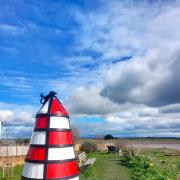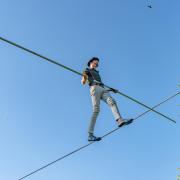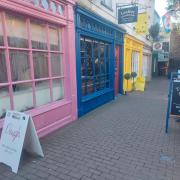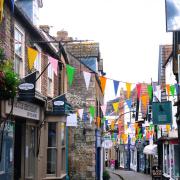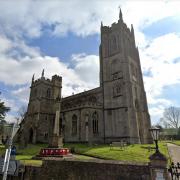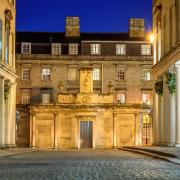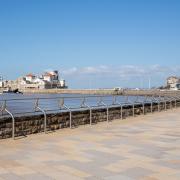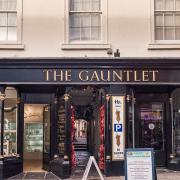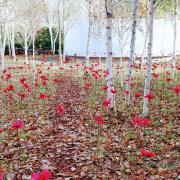CATHERINE COURTENAY takes a look at Taunton’s green spaces and discovers a legacy that’s continuing into the future

It’s a shopping destination, it has restaurants, cafes and entertainment, it has a fascinating history and heritage, but Taunton is also home to award-winning parks and green spaces.
Somerset’s county town has an enviable horticultural heritage. Close to the centre of the town lies Vivary Park, so named because in Medieval times it was the site of a fish farm, or vivarium, for the priory and castle.
Although it didn’t become a public park until it was sold to the council in 1894, it had previously been used for various events, including the first Taunton Flower Show in 1851.
At that time the land was owned by Mr Kinglake of neighbouring Wilton House, who’d bought the site in 1810. In her book, Taunton Flower Show, author Anne Leamon says that previously, ‘the public were able to stroll through the fields and Mr Kinglake allowed the area to be used for public entertainment and cricket matches at times’.

That first flower show at Vivary saw a large marquee set up to house the various plants, flowers and fruit. Anne says that the show, which was attended by nurserymen from the surrounding area, including Mr Kelway at Langport, opened at 1pm with an admission charge of 1s. By the end of the day, the grand sum of £16 had been raised.
The show has continued to this day, in Vivary Park, making it the oldest and longest running flower show in the country.
After it was sold by Mr Kinglake to the council in 1894, Vivary was laid out as a formal park with the planting undertaken by the famed Veitch & Son of Exeter. It provided 1,325 plants and shrubs at a cost of £128.10s, reports Anne. The original layout included the front gates, bandstand and a shelter which can still be seen. In 1907 the park’s fountain was unveiled, a memorial to the late Queen Victoria.
Taunton has every reason to be proud of Vivary Park. Its entrance gates alone are an impressive sight, more akin to something you’d find in a major city. The 7.5 hectare space pulls in both visitors and locals, and along with the landscaped grounds it has an impressive adventure play area, golf course and crazy golf, tree trail, tennis courts and a bowling green.

Vivary Park, along with the town’s Victoria and French Weir Parks were awarded Green Flag status last year, an international award given to parks and green spaces that have the highest possible environmental standards, are beautifully maintained and have excellent visitor facilities.
After entering for the first time, Comeytrowe Park, which is an outdoor games area near Musgrove Park hospital, won a Community Green Flag Award, thanks to the hard work of the Friends group that runs it – the judge praised the ‘passionate and dedicated’ volunteers, and said their enthusiasm was ‘infectious’.
Taunton certainly values its green spaces and is moving with the times; a scheme announced this year involves working with Somerset Wildlife Trust to create a series of meadow areas throughout the town.
Acknowledging that longer grass and meadows can help biodiversity, create habitats for wildlife - and having officially declared a climate emergency last year – Somerset West and Taunton Council is creating meadows on land it owns at Grange Drive, Leycroft Grove and Moorfields and is also setting aside areas of Vivary, Victoria, Comeytrowe and French Weir parks.
The plan is to begin this spring, with preparing and sowing the areas. Wildflower meadows need poor soils, so it may take time for flowers to grow on enriched soil, but the council says it will be taking it slowly and talking to local communities to gauge their opinions. The idea is to get it right in a few areas before extending the scheme elsewhere. If successful, paths will be cut through the meadows to allow people to walk through them.
Meanwhile, on the edge of Taunton lies another example of its unique horticultural and green space heritage.
The 50 acres of gardens at Hestercombe are indeed an historical treasure and they include a Georgian landscape garden, a Victorian shrubbery and an Edwardian formal garden.
Created by Coplestone Warre Bampfylde, who inherited the estate in 1750, the landscape garden was major feat of garden planning. He made a spectacular waterfall and created tranquil ponds around which are paths that lead to various viewing points, arbours and alcoves.
The formal garden is a collaboration of two of the most famous Edwardian designers. Sir Edwin Lutyens was commissioned to create the garden in 1903, with a planting scheme by Gertrude Jeykll. It’s widely thought to be one of the best examples of their combined work.
Today, the gardens are a beautiful sight, but that was not the case in 1973. At that time, Hestercombe was the home of Somerset Fire Brigade and the gardens had become run down. But then something unprecedented happened. Somerset County Council, with the support of the fire brigade, began a project to restore the formal garden; it was the first time a local authority had ever attempted anything of this kind. They were helped by the discovery of some of Jekyll’s original planting plans in a drawer of a potting shed – plans that had lain undisturbed for 70 years.
In 1996, the Hestercombe Gardens Trust was set up to continue restoration work, which extended to the landscape garden, so adding another jewel to Taunton’s gardens and parkland legacy.
A garden town
Taunton was awarded Garden Town status by the Government in 2017. It’s a funding scheme linked to housing plans drawn up by Somerset West and Taunton Council for around 11,000 new homes focusing on developments at Monkton Heathfield, Staplegrove and Comeytrowe – as well as in the town centre.
The idea is to create ‘garden communities’ in the suburbs, designed with landscape and wildlife in mind and creating high quality, self-sufficient communities for people to live in. Within Taunton town centre itself, there are plans to create more pedestrian and cycle links between the various green spaces and to promote the River Tone as a ‘green corridor’, recognising its benefits for wildlife and people.
The photographer
Many of the photographs for this feature were taken by professional writer and photographer Nigel Hicks. Nigel’s latest book, Beautiful Somerset, includes a series of photo essays from across the county, including Bath and Bristol. It’s available from bookshops, some visitor attractions and online stores, including aquaterrapublishing.co.uk at £9.99. nigelhicks.com






